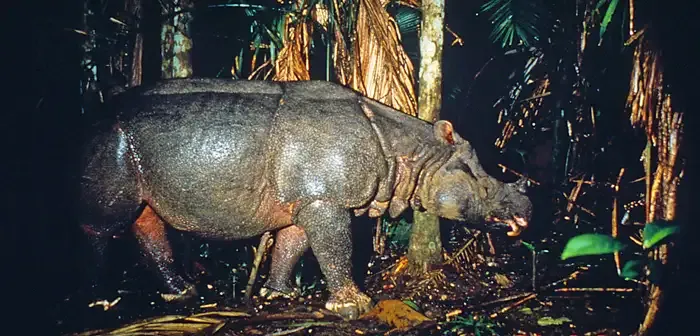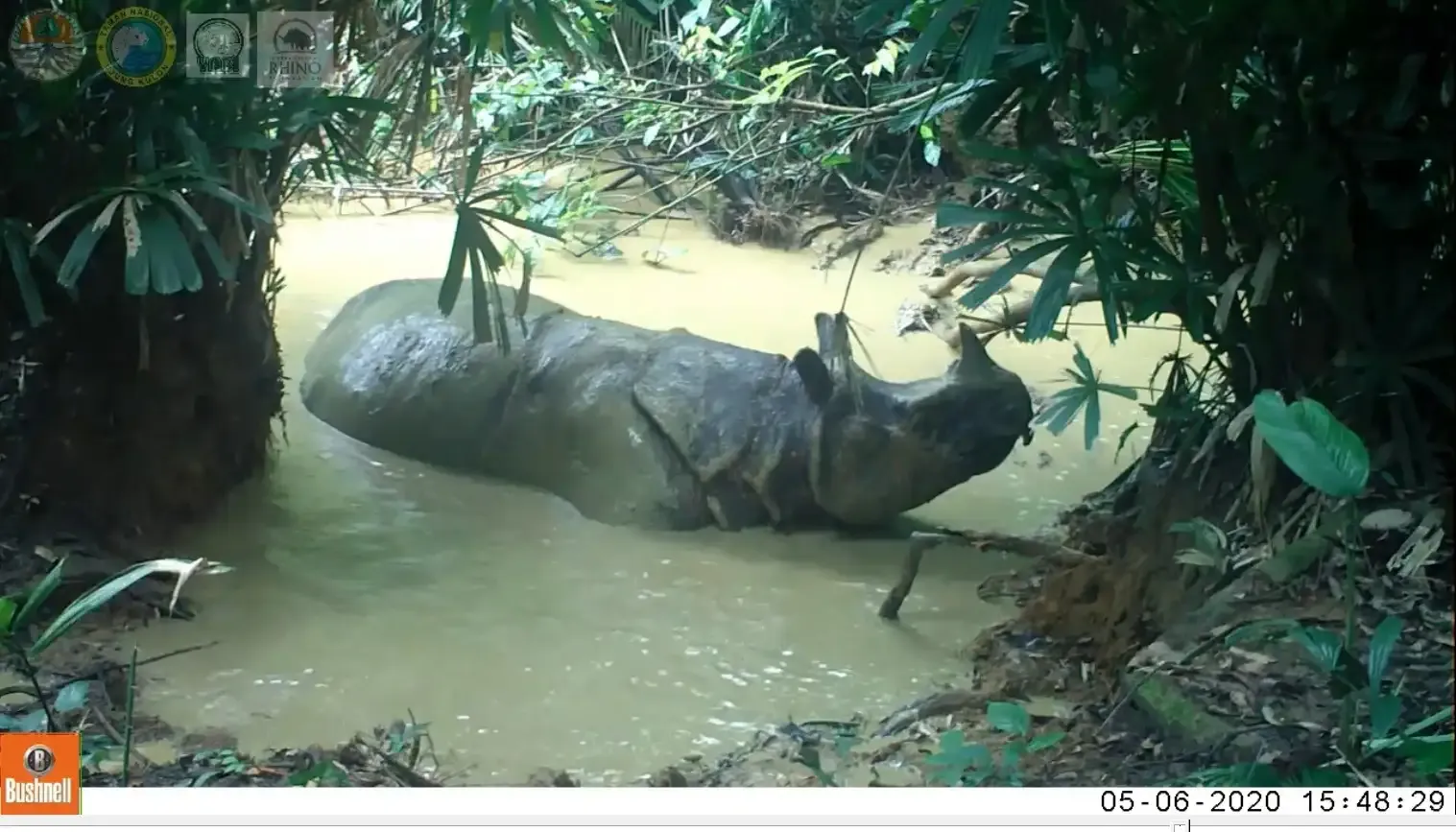Javan rhino (Rhinoceros sondaicus), also known as the small one-horned rhinoceros, is a critically endangered member of the genus Rhinoceros, family Rhinocerotidae, and one of the five remaining rhinoceros species found in South Asia and Africa.
The Javan rhino is among the smallest of the rhinoceros species, alongside the Sumatran rhinoceros, also known as the “hairy” rhino. They superficially resemble the Indian rhinoceros, with protective skin folds that look like “armor,” but are smaller, with an average body length of 3.1–3.2 meters (10–10.5 feet) and a height of 1.4–1.7 meters (4.6–5.6 feet).

The heaviest specimens can weigh up to 2,300 kg (2.3 tons), similar to the black rhinoceros. However, unlike the long and potentially deadly horns of the black or white rhinos in Africa, the Javan rhino’s single horn (which is only found in males) typically measures less than 25 cm (9.8 inches).
Historical Range and Population Decline
Until the mid-19th century to the early 20th century, the Javan rhinoceros spread beyond Java and Sumatra to mainland Southeast Asia and Indochina, extending as far north as eastern India, Bhutan, and southern China.
Today, the Javan rhino is the rarest of all rhinoceros species and one of the rarest living species, with only one known wild population remaining. No individuals have been successfully maintained in captivity.
The Javan rhinoceros is among the rarest large mammals on Earth, with a population of around 74 individuals in Ujung Kulon National Park, located at the westernmost tip of Java, Indonesia. In 2023, Indonesian authorities arrested two groups of poachers who had admitted to killing 26 rhinos between 2019 and 2023. No census has been released since 2019. The Javan rhinoceros in Cat Tien National Park, Vietnam, was declared locally extinct in 2011.
Causes of Population Decline
The decline in the Javan rhino population is primarily caused by poaching, as male rhino horns—despite being made of keratin—are highly prized in traditional Chinese medicine, fetching up to $30,000 per kilogram on the black market.
Alongside the increasing presence of Dutch colonialists and other Europeans in the region, trophy hunting also posed a serious threat in the 1700s–1800s.
Habitat loss and massive human population growth, particularly after wars like the Vietnam War, further contributed to the species’ decline and hampered recovery efforts.
The remaining habitat is protected within a national park, and Ujung Kulon is also a UNESCO World Heritage site. However, the park’s rural and sometimes rugged boundaries mean that law enforcement cannot be present everywhere at all times; in some areas, this lack of security still places the species at risk from poachers, disease exposure, and ultimately, the loss of genetic diversity—leading to a genetic “bottleneck” (i.e., inbreeding depression).
Life and Behavior
Javan rhinos can live for about 30–45 years in the wild. Historically, they inhabited dense tropical rainforests, wet grasslands, and large floodplains along forest edges. They are mostly solitary, except during mating or when raising young, although groups may sometimes gather near mud wallows or salt licks.
Aside from humans, which they generally avoid, adult rhinos have no natural predators in their habitat. Very young calves might be preyed upon if left unattended, typically by leopards, Sumatran tigers, or, rarely, by crocodiles.
Scientists and conservationists rarely study these animals directly due to their extreme rarity and the risk of disturbing the endangered species. Researchers rely more on camera traps and fecal samples to assess health and behavior.
As a result, the Javan rhino is the least studied of all rhino species. In February 2011, WWF and the Indonesian National Park Authority released footage from a motion-triggered camera trap, capturing two adult female Javan rhinos, each with a calf, confirming that the species is still breeding in the wild. More footage showing 35 individuals, including mother-calf pairs and mating adults, was released in April 2012.
Naming and Taxonomy
The genus name Rhinoceros is derived from the Greek words ῥίς (rhís), meaning “nose,” and κέρας (keras), meaning “horn.” The species name sondaicus comes from the “Sunda” biogeographic region, which includes Sumatra, Java, Borneo, and other small islands. The Javan rhinoceros is also called the “small one-horned rhino” to distinguish it from the larger “one-horned rhino,” the Indian rhinoceros.
The first study of the Javan rhinoceros occurred in 1787 when two specimens were shot in Java. The rhino bones were sent to Petrus Camper (Netherlands), but he died in 1789 before publishing his findings that the Javan rhino was a distinct species.
Another specimen was shot on Sumatra by Alfred Duvaucel, and the specimen was sent to his stepfather, Georges Cuvier (France). Cuvier recognized the animal as a separate species in 1822, and the same year it was identified by Anselme Gaëtan Desmarest.
Desmarest used the scientific name Rhinoceros sondaicus to describe the Javan rhino sent to the French National Museum of Natural History by Pierre-Médard Diard and Alfred Duvaucel. Over the 19th century, various specimens of hornless rhinos were described:
- Rhinoceros inermis, proposed by René Lesson in 1838 for a female rhino without a horn shot in Sundarbans.
- Rhinoceros nasalis and Rhinoceros floweri, proposed by John Edward Gray in 1867 for rhino skulls found in Borneo and Sumatra.
- Rhinoceros annamiticus, proposed by Pierre Marie Heude in 1892 for specimens found in Vietnam.
In 2005, three subspecies of the Javan rhinoceros were considered valid taxa:
- R. s. sondaicus – the Indonesian Javan rhinoceros, which once lived in Java and Sumatra. Currently, the population is around 40-50 individuals in Ujung Kulon National Park. Some researchers suggest that the Sumatra population might represent a different subspecies, R. s. floweri, though many experts have not agreed with this.
- R. s. inermis – the Indian Javan rhinoceros, which once lived in Bengal and Burma (Myanmar), but is considered extinct by the early 1900s.
- R. s. annamiticus – the Vietnamese Javan rhinoceros, which once lived in Vietnam, Cambodia, Laos, Thailand, and Malaysia. It is now thought to be extinct in Vietnam, with an estimated population of fewer than 12 individuals remaining in Cat Tien National Park.
Evolution
The Indian rhino is closely related to the Javan rhino; both species are the only members of the genus Rhinoceros. Fossil records show that both species first appeared in Asia during the early Pleistocene. Molecular data suggests they diverged much earlier, approximately 11.7 million years ago.
Although they belong to the same genus, the Javan and Indian rhinos are not closely related to other rhino species. Various studies suggest that they share a common ancestor with extinct species such as Gaindetherium and Punjabitherium.
A detailed phylogenetic analysis of the Rhinocerotidae family has grouped the Rhinoceros genus with Dicerorhinus, the Sumatran rhinoceros

